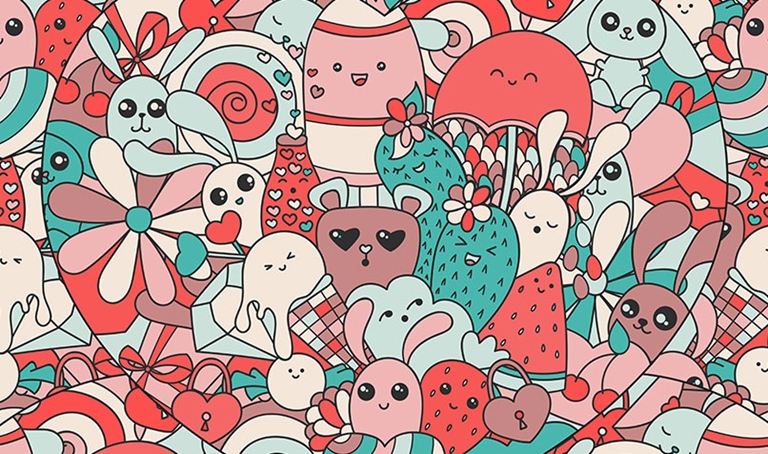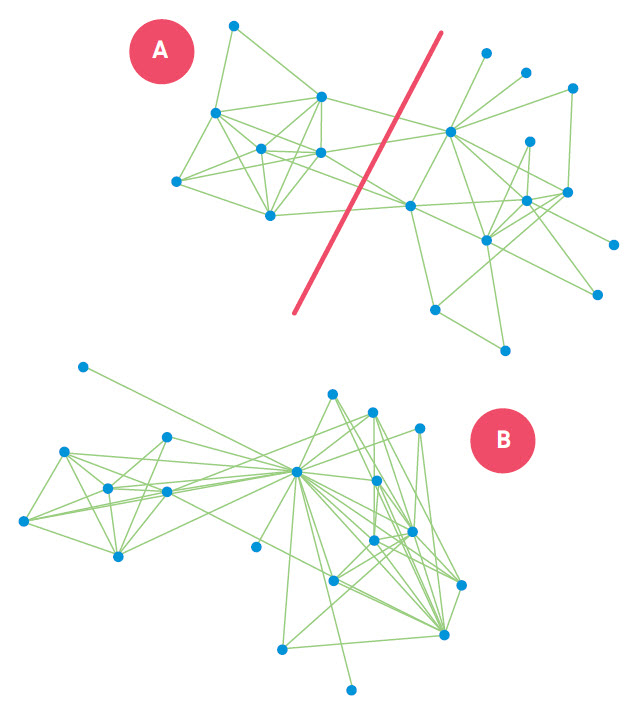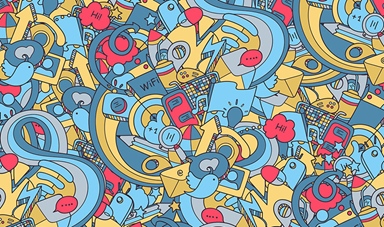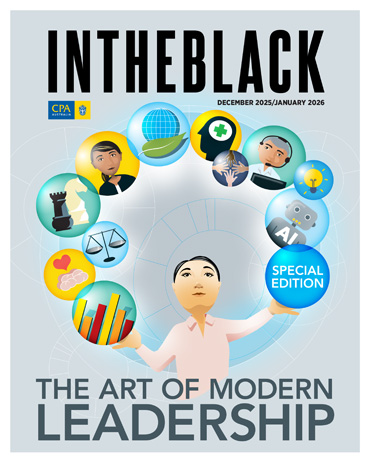Loading component...
At a glance
- Social network analysis (SNA) can provide insight into social influences within teams, and identify cultural issues.
- The research conducted for SNA is interested in individuals, but the analysis itself focuses on connectivity: how individuals collaborate.
- SNA has been used as a strategic approach to team building, and to understand how team building can change the dynamics of an organisation’s social network.
Consider two variations of a situation with which we are all familiar – the high school exam. In one version, the rules are as we expect them to be. The students must sit in silence, must not communicate with anybody and cannot even glance sideways. In another version, the teenagers are welcome to communicate with their classmates, are encouraged to walk around and compare notes, and those who excel in the topic are placed among weaker groups and rewarded for sharing their knowledge.
The results for those in the latter scenario would, of course, be far higher as a group than those in the traditional situation. This is why organisations put great effort into establishing a collaborative culture, because it boosts levels of performance. At least, that’s what it is supposed to do.
How does a business know whether the right people are having the right conversations? How does it identify the real influencers and the most powerful channels for information sharing? If culture turns bad, as it can in particular departments or business units, how has that negativity arrived and spread?
Several years ago, Swinburne University of Technology’s Professor Dean Lusher, head of the Social Network Research Lab and program leader within the Social Innovation Research Institute, did some work with Australian Football League (AFL) teams. This was during a period in which serious cultural issues, including sexual assault, were damaging the AFL’s reputation.
He used social network analysis (SNA) to shine a light on the social influences within team structures in order to identify where the cultural problems began and how they spread.
“We analysed the social dynamics of the team, including who individuals socialised with after hours, and what attitudes the individuals held,” Lusher says. “We found in some clubs that players who had these playboy attitudes were more likely to be people who others socialised with.
“Then, since everyone is choosing these individuals in their social lives, these individuals become influential within the team. Their voices are heard more than others.”
Going back to the example of the exam hall, imagine a student who is offering advice on how to answer certain questions, but whose advice is incorrect. Their communications will damage the performance of the group.
“Social network research is not so much about focusing on individuals, which is a classic way of doing research in organisations and in societies. We’re interested in the social systemic aspect,” explains Professor Garry Robins, a professorial research fellow at the University of Melbourne and, like Lusher, a well-respected expert in the field of SNA. Robins uses the exam hall example to describe aspects of SNA to the uninitiated.
“We’re interested in how things work together. For instance, how a team collaborates or whether an organisation transmits its internal knowledge efficiently. It’s more of a connectivity question, but the two – individuals and connections between individuals – are not mutually exclusive. Social network research is interested in individuals, but the connectivity is the most important thing.”
There are various ways of conducting the analysis, Robins says. The “quick and sometimes dirty” method of gathering data is to analyse electronic traces – email patterns and meeting diaries, for example, to figure out patterns of interaction between various individuals.
“This method can be a bit rough and ready because there are lots of reasons to send an email, and you may not really get to the heart of it,” Robins says,“but if you’re prepared to dig deeper, you can survey people to find out who they collaborate with most closely. Then you should burrow into the organisation, collecting any relevant data on the organisation and its people. This must be done with a degree of sensitivity and care, but you’re likely to answer more carefully formulated questions that way.”
The science of SNA is not just making its way into the corporate world. It has been utilised to help experts understand how school students learn, what patterns diseases follow as they spread, the interactions that lead to romantic relationships, and the likelihood of an individual becoming a criminal or falling victim to crime.
Social network analysis for team building

Dr Julien Pollack, associate professor of project management at the University of Sydney, used SNA to facilitate a team building process when two teams in an organisation were brought together under one manager.
“There were actually two things going on,” Pollack says.
“One is that we were using it to strategically personalise an approach to team building. We were making sure the team building was applied in the most appropriate way for the people in that context, but we were also using it to understand how the team building actually changed the social network in that environment.”
The process offered the SNA experts a nuanced way of evaluating the effectiveness of the team building.
Traditionally, team members would be surveyed about whether they enjoyed and benefited from the team-building process. Perhaps certain performance metrics would be measured several months after the team-building exercise.
However, the SNA modelling allowed the researchers to dig deeper and see real evidence of change, aspects of the network of communication or interaction that were previously invisible.
“It allows you to visually or statistically describe what’s going on in a much larger network or system of communication,” Pollack explains.
“Managers can often make a good guess about what Bob or Jack does or who they’re connected to, but because they’re not actually in their shoes, they can’t see the vast majority of the interactions and effects they have.”
Pollack is not saying that traditional team-building exercises should become a thing of the past. An outdoors adventure or a social evening provides shared experience that helps to bring a group together, but it is a very blunt tool compared to the surgically precise way that SNA can inform activities such as team building.
Identifying the influencers
In the fields of change management, culture development, performance management and so many more, insight offered by SNA is a powerful tool. In today’s business environment, a professional working in corporate communications, for example, has a variety of different communication mechanisms. One of those is engaging with specific people, with influencers.
Who are the real influencers? Logic says they’re the managers, those who interact daily with most of the staff on their teams. Evidence says otherwise.
“How do you know who are the most influential people in a group?” Pollack asks. “We all play different communication roles. Some of us are quite isolated, while some have intense communication with a small group. Others act more like brokers connecting different groups. Some people are very central to a network as a lot of information passes through them. Different patterns of communication suit different job roles.”
SNA allows the company to choose who it is communicating through, to achieve maximum dissemination of its message.
“Let’s say I was rolling out an organisational change, and I wanted to bring people in as change agents or change champions,” Pollack says. “I wouldn’t necessarily want to choose the person who is as far up the organisational ladder as possible. They might be quite isolated. I want to choose people who have a lot of social capital, who have a lot of sway in the organisation. Social network analysis gives you a way of uncovering that.”
To create a clearer process and path of use for SNA as a business tool, Lusher has recently co-founded a start-up out of Swinburne University of Technology. It’s called SNA Toolbox, and it will provide the functionality that organisations in various industries will require to understand hidden social relationships, and therefore hidden social capital. It will answer the question around what an organisation should do once it has identified these networks and, from an accounting perspective, it could also be a risk-management and governance tool.
“More and more people say, ‘Well, so what? What do I do now?’,” Lusher says. “We need to move beyond diagnosing and start to give suggestions about what people might do.
Humans are complex beasts, so social interactions within an organisation can be incredibly complex. We’re now at the start of an exciting journey, beginning to understand how we create greater influence within businesses.”
A criminal social network analysis case study
The Community Oriented Policing Services division of the US Department of Justice released a report called Policing the Connected World: Using Social Network Analysis in Police-Community Partnerships to illustrate the ways that various police departments are using SNA in their everyday work.
In one project, the report states that “a focused deterrence framework” was applied to address group and gang violence.
“In cooperation with the New Haven Police Department, the US Attorney’s Office, and local service providers and community members, the research team 1) gathered group-level information on location, membership, illegal activities, and the relationships between street groups, and 2) mapped the relationships between these groups to identify the most violent groups in New Haven, and guide the implementation of the violence reduction strategy.”
The mapping of relationships is what SNA is all about. It clearly identifies patterns that were previously invisible, and in the workplace this can be of great value.
Social networking in action

A network diagram of a team can visualise potential communication gaps. The circles in the diagram stand for team members, and lines depict the most comfortable relationships. Team members who are more comfortable with each other are placed closer together.
The above two diagrams are the same group three months apart. In scenario (A), the group was split into two subgroups that were relatively comfortable communicating with each other.
The group had, in fact, been two teams, brought together under a single manager. They were co-located, but still largely working as two separate groups.
The company’s management thought team building might help bring the subgroups together. Scenario (B) shows the team three months later. There were more connections within the group, with one individual particularly pivotal in unifying the team.
What caused this change? Not traditional team-building exercises, but “targeted self-disclosure exercises”.
Source: Dr Julien Pollack, Dr Petr Matous

